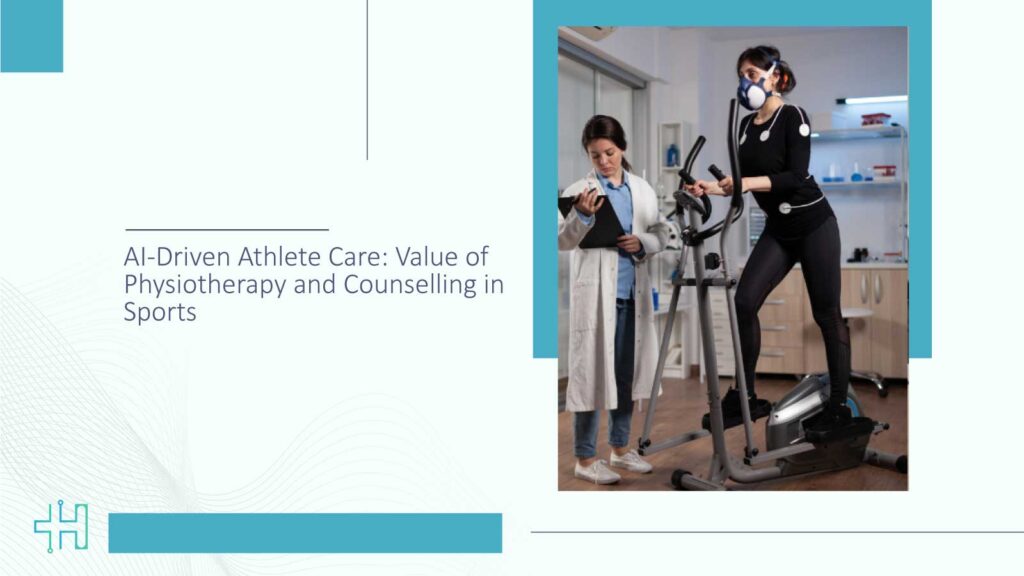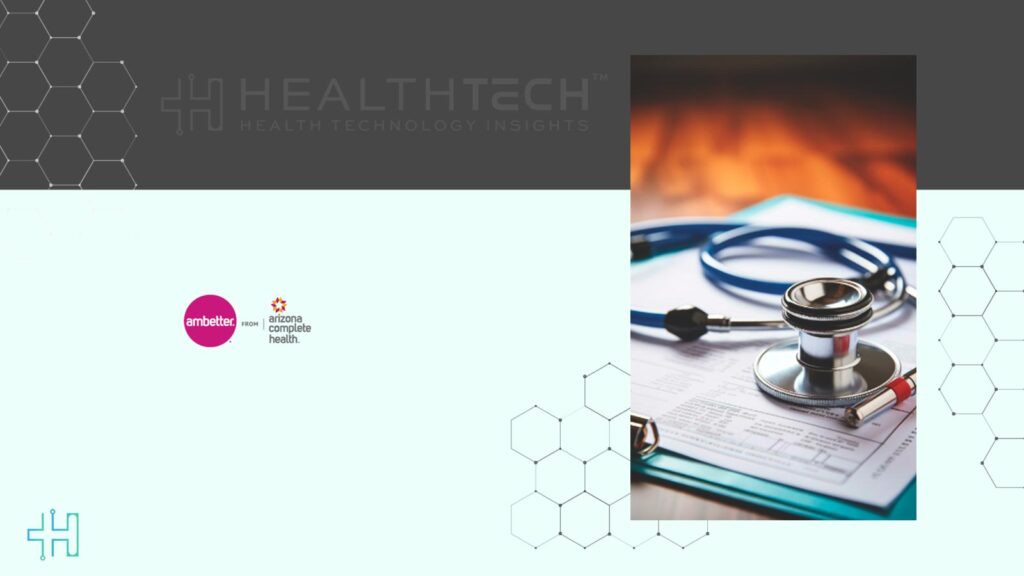Think of a scenario where a sprinter who is ready to compete in a national championship final suddenly experiences hamstring pain. A few weeks off could put to waste the result of months of training. But AI-driven athlete care is changing the story. By combining physiotherapy and counseling with smart analytics, athletes not only get the recovery they require in less time but also are able to prevent injuries themselves.
Artificial intelligence (AI) in athlete care is a major change that profoundly affects how athletes need to heal, how they can perform, and even their physical and mental growth. Everywhere technology is used, from data-driven rehabilitation to AI-managed stress reduction; thus, athletes can safely and sustainably reach their peak with the help of the technology that is entering their locker rooms and clinics.
The integration of AI, physiotherapy, and counselling
Now with AI, the convergence of physiotherapy and counseling is resulting in more accurate, customized, and anticipatory ways. Recovery and mental wellness are no longer two different things that are treated separately.
What AI does is that it enables these components to cooperate closely by giving athletes the output and the input of treatment they could hardly have ever conceived before.
Personalized Physiotherapy Through AI
In a typical physiotherapy scenario, the patient’s treatment depends largely on certain standard procedures and the therapist’s judgment. While they are efficient, they still leave some areas that AI can fill. What if there were a tool that not only watched every step, squat, or stretch of an athlete but also studied the related biomechanical data and figured out the subtle trends that could lead to the risk of injury? That’s what physiotherapy powered by AI is like.
One such company, Sword Health, has created an innovative platform supported by AI, which is capable of not only designing but also constantly modifying highly personal rehabilitation regimens based on the AI’s understanding of previous injuries and muscle imbalances, as well as live patient feedback. The athletes under these programs usually experience their recovery periods shortened and have fewer regressions.
Mental Health Counselling Enhanced by AI
Rehabilitation from injury is only one side of the coin. The truth is that stress, anxiety, and performance pressure may be some of the biggest silent enemies that hinder an athlete’s progress. To keep track of mental well-being, AI tools now employed in this field recognize changes in the speech pattern, physiological indicators, and behavioral cues of a person.
As an example, AI chatbots can be the first line of support for athletes who are going through anxiety before a game, while predictive models can identify early burnout or depressive symptoms. The use of AI in therapy means that mental wellness is given as much attention as physical health; thus, a holistic approach to athlete care is achieved.
Why AI-Driven Athlete Care Matters
Knowing real-life examples of AI-driven athlete care benefits gives us a better understanding of why this technology is becoming a must-have. There is a multitude of benefits, starting with a quicker recovery to intelligent injury prevention. AI is not merely a supportive tool for making treatments more effective, but it is also fundamentally changing the whole athlete care experience.
1. Accelerated Recovery
AI is constantly monitoring various data that relate to performance and does not simply wait for a scheduled consultation. When the bending of the knee of an athlete is not improving at the rate expected and therefore slowly, then AI quickly suggests the change that needs to be done. The impact of this means that the athlete gets well again more quickly and cannot afford to lose very many days to the injury.
The present-day usage of intelligent weight-bearing robots for post-ACL surgery rehabilitation is scientifically proven to enhance knee function, alleviate pain, and shorten the duration of the hospital stay. This was the finding of a 2025 study that was published in Frontiers in Public Health.
2. Proactive Injury Prevention
Predictive analytics is, on the other hand, the AI-driven athlete care facility’s center. Through the analyses of patterns in training load, movement mechanics, and previous injuries, AI is capable of predicting injuries that might happen in the future.
Coaches can leverage this data to make minor adjustments to the training plan or suggest pre-habilitation exercises. It is very important for high-impact sports such as basketball, soccer, and sprinting, in which a player is at risk for only a few days in case of even a slight injury, to be able to benefit from this perspective.
3. Continuous Monitoring via Wearables
The technology embedded in smart insoles, for example, and sensor-laden compression sleeves allows wearables to collect really detailed data about biomechanics, heart rate variability, and muscle activation. All the time, AI algorithms are at work with this data, and so the output they give is a 24/7 health snapshot.
Those who make decisions at sports organizations are given, through this, the very practical pointers they need concerning workload management, recovery needs, and early warning signs, thus facilitating athletes to train not harder but smarter.
4. Holistic Mental Health Oversight
Mental resilience is as important as physical strength. AI platforms analyze subtle signals like micro-expressions, voice inflections, or even typing patterns to detect stress and mood fluctuations. Early detection allows coaches, physiotherapists, and psychologists to intervene before mental fatigue translates into physical setbacks.
Case Studies: AI at Work in Athlete Care
Across clinics and professional sports teams, AI is moving from theory to practice, transforming how physiotherapy and counselling are delivered and elevating outcomes for athletes at every level.
1. Riverside Sports Therapy, Canada
Riverside Sports Therapy uses AI to analyze biomechanics in real time, predict injury risk, and personalize rehabilitation plans for elite athletes. Since implementing AI, the clinic reported improved outcomes, higher patient satisfaction, and fewer re-injury occurrences.
“Thank you for keeping me in one piece so I could be at my best for the CrossFit Games,” shared Geoffrey Aucoin, CrossFit athlete.
2. Tech-Forward Teams in Professional Sports
Several professional soccer and basketball teams in the U.S. now use AI-driven platforms for physiotherapy and mental health monitoring. The results? Enhanced player availability, reduced rehabilitation time, and optimized performance metrics.
The Future of AI in Athlete Care
The next frontier involves integrating virtual reality (VR) with AI-driven physiotherapy. Imagine an athlete navigating a VR course designed to enhance proprioception while AI tracks every joint angle and muscle engagement.
Predicted trends:
- AI-enhanced predictive counselling: Mental health models will anticipate stress patterns before they manifest.
- Hyper-personalized rehab programs: AI will continuously adapt exercises based on real-time data.
- Expanded decision-support systems: Teams and healthcare leaders will leverage AI insights for operational and medical decisions.
As these technologies advance, athlete care will shift from reactive treatment to preventive, predictive, and personalized management, ensuring that both physical and mental performance are optimized.
AI as a Game-Changer in Sports Health
AI-driven athlete care is transforming sports medicine. By integrating physiotherapy and counselling into a unified, technology-enhanced approach, athletes gain faster recovery, fewer injuries, and stronger mental resilience.
For health tech leaders, decision-makers, and innovators, this is more than a technology trend. It’s an opportunity to redefine how athlete care is delivered, measured, and optimized. The combination of AI, physiotherapy, and counselling offers a compelling roadmap to safer, smarter, and more sustainable athletic performance.
FAQs
1. How does AI improve physiotherapy outcomes for athletes?
AI analyzes biomechanical data, prior injuries, and real-time feedback to create personalized rehabilitation plans, improving recovery speed and reducing re-injury risk.
2. Can AI monitor mental health in athletes effectively?
Yes. AI tools detect subtle indicators of stress, anxiety, or burnout, enabling timely intervention and supporting holistic well-being.
3. What types of wearables are used in AI-driven athlete care?
Smart insoles, sensor-equipped compression sleeves, heart rate monitors, and motion trackers are commonly used to gather continuous performance and health data.
4. How do predictive analytics prevent injuries?
By analyzing patterns in movement, training load, and physiological responses, AI predicts potential injuries, allowing preventative adjustments to training or therapy.
5. What innovations are expected in AI-based athlete care?
Future trends include VR-assisted rehabilitation, predictive mental health support, hyper-personalized exercise programs, and comprehensive data-driven decision-making tools.
Dive deeper into the future of healthcare. Keep reading on Health Technology Insights.
To participate in our interviews, please write to our HealthTech Media Room at sudipto@intentamplify.com







